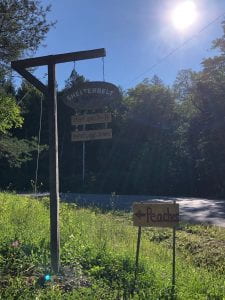Summer is speeding along! This week marked the conclusion of my solar interviews and a shift to focus on synthesizing my interviews into final deliverables.
T and Barb and I took a road trip out to Naples, NY to visit a grass-fed beef and lamb operation, Sweet Grass Meats. This visit was special because the farmers are my field mentor, Mary Kate MacKenzie, and her husband Leith. Mary Kate and Leith fulfill a vegetation management contract by periodically grazing a portion of their sheep on a solar site in Geneva, through the company Agrivoltaic Solutions, LLC. Their flock will not be back on the solar site until the end of the summer, so we saw them grazing at the home farm today. Part of the flock was completing vegetation management on DEC lands on the day we visited. We also got to watch the beef herd move paddocks, herded by the trusty farm dog, Fran, during our pasture walk. I was glad to meet Mary Kate in person and was able to learn a great deal from the MacKenzies about sheep as vegetation managers.









We noted roadside solar development on our return trip, and of course had to try another Central New York ice cream spot, the Spotted Duck Creamery in Penn Yan. The ice cream flight did not disappoint, and was made using eggs from the ducks raised on site! We ended the day with a stop to feel the spray of Shequaga Falls, a Montour Falls landmark.





I continued the week with an interview with Delaware River Solar, a developer with projects in Tioga County. I also visited Shelterbelt Farms to speak with Erica Frenay, a Cornell Small Farms employee, farmer, and American Solar Grazing Association board member. Her sheep are also solar grazers through Agrivoltaic Solutions, LLC. In addition to talking about agrivoltaics, I was able to see goats, sheep, cows, a fruit orchard, and various ponds that Erica installed to manage water on her farm.




I spent much of this week synthesizing my learnings from reading literature and completing interviews to compose three factsheets. These factsheets will be distributed by CCE Tioga to farmers, landowners, community stakeholders, developers, and any people curious about solar energy and agrivoltaics. I received input on these materials from T, Barb, and some of my colleagues in the regional Ag-Solar working group. I also continued to develop a decision matrix that can guide landowner and municipality decisions about solar development. Finally, I contributed to a meeting with some local government members and Tioga County Soil & Water Conservation District focusing on soil health as it relates to solar projects.
I have learned so much this summer about agriculture, solar power, and environmental decision making. Synthesizing my interview findings has allowed me to reflect on all I have learned, and I look forward to completing my deliverables next week and continuing to process the takeaways and growth from this summer.

